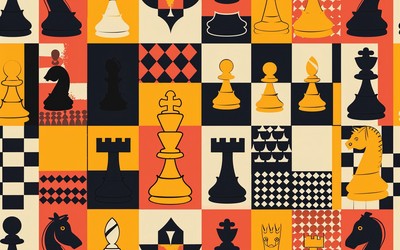
DALL-E
The Woodpecker Method
Unpacking a controversial chess improvement strategyThe Woodpecker Method is an approach to chess training where you do the same puzzles repeatedly at faster and faster intervals. It’s been advocated in a book of the same name by Axel Smith and Hans Tikkanen. Earlier, an American amateur named Michael De La Maza proposed a similar method in Rapid Chess Improvement. The authors report fantastic results with this method: Tikkanen scored three GM norms in a seven-week period after going through the program, and De La Maza went from 1400 to over 2000 USCF in a couple years. Of course, in chess what works for one person may not work for another. So the big question is, would the Woodpecker Method work for you?
Well, compared to what? Compared to not working on chess at all, I would certainly expect doing the Woodpecker Method to give you a better chance of improving. But that’s not a very interesting comparison. What about compared to solving tactical puzzles according to some other program? The Woodpecker Method is, after all, a form of solving puzzles, which is one of the most common ways of working on chess. What makes it different from other kinds of solving is the idea that you should do the same puzzles repeatedly. This suggests a more useful reframing of the question:
If you’re going to solve tactical puzzles, is it better to do the same puzzles repeatedly, or do a steady stream of new puzzles?
My intuitive answer to this question would be that new puzzles are better. The reason is simple: When you solve puzzles, you don’t really care about your ability to solve that exact position, because it’s unlikely you’d ever get it on the board in a real game. What you really care about is the ability to solve new, unseen positions. Doing the same puzzles over and over introduces the risk that rather than developing the skills to tackle unseen positions, you’ll simply memorize the positions in your puzzle set.
In machine learning there’s a name for this phenomenon: overfitting. In many forms of machine learning you start with a training set, a collection of labeled data that illustrates what you want your model to learn. For example, if you’re training a model to recognize dog breeds, your training set would be a collection of images of different kinds of dogs with the correct breeds labeled by hand. You’d like your model to learn the characteristics of different dog breeds so that it can correctly identify the breed of a picture of a dog it hasn’t seen yet. So hopefully it will learn, for example, that Shih Tzus tend to be smaller than Great Danes. But suppose for some reason a lot of the images of Shih Tzus in your training set were taken during the day, whereas your Great Dane images were taken in the evening. Your model might learn that brighter images are more likely to be Shih Tzus. But of course this doesn’t really make sense, and could cause it to make a mistake if you show it a new picture of a Shih Tzu at night. This kind of spurious pattern is an example of overfitting.
Is this a realistic concern for the Woodpecker Method? I think it is. I recently started working through Imagination in Chess, a book of puzzles that I’ve done several times. (If we’re being honest, I’ve done the first chapter several times.) Despite not looking at it in years I definitely remember a lot of the positions. More generally, the speed of the suggested progression in the Woodpecker Method suggests to me that there has to be some memorization going on. In the final cycle of Tikkanen’s program he solved one thousand puzzles in a single day. It seems implausible that your overall tactical ability could improve so much, so fast. To some extent you must be memorizing the specific positions, even if unconsciously.
So the theory behind the Woodpecker Method doesn’t make a ton of sense. Nonetheless, Tikannen and De La Maza made tremendous progress while using it, and many other chess players have had success with it as well. What gives? To answer that, I started thinking about another training program: Crossfit. This might seem like a strange comparison, not only because it’s an athletic training program, but also because the core idea is the opposite: in the Woodpecker Method you do the same thing over and over, whereas Crossfit is all about doing something different every day. According to their website, the program involves "constantly varied functional movements executed at high intensity across broad time and modal domains." From what I can tell, most professional trainers are not very impressed with the Crossfit method, preferring a more structured training plan targeted at specific adaptations. Nonetheless, a lot of people I know love Crossfit. I play Ultimate Frisbee and there’s a big overlap between the Ultimate and Crossfit communities. Chess power-siblings Greg and Jennifer Shahade are also Crossfit enthusiasts.
Crossfit and Chess: Shahade vs Shahade
I suspect the success of Crossfit has less to do with the varied workouts and more to do with other aspects of the program:
- Consistency: You get in the habit of showing up and doing a workout every day.
- Community: You do the workouts with a group of likeminded people.
- Accountability: Being part of a group creates pressure to stick with the plan.
- Convenience: You don’t have to design a workout every day, you just show up and do what everyone else is doing.
- Tangible progress: You periodically do benchmark exercises and see your numbers go up.
The Woodpecker Method provides many of the same benefits. Not so much community (although it would be a great idea to do it in a group), but it promotes consistency by giving you a long term plan to follow. In fact, the challenge of both designing and executing your training plan is an underrated part of what makes chess improvement hard. In effect, you have to be both the coach and the athlete. When you’re in charge of the training plan, it creates a lot of opportunities for second-guessing, flip-flopping, or skipping training altogether. It’s much easier to simply follow a plan that’s already in place. Another thing that makes chess improvement hard is the prevalence of long plateaus or stretches where you don’t make any tangible progress. But when you do the same puzzles repeatedly you get to see your performance improve quickly. As I argued above, part of this improvement is probably due to effectively memorizing the puzzles and therefore won’t translate to real games, but it still feels good. When you can see tangible progress in the form of solving the puzzles faster and getting more right, you’re more likely to stick with the program. In short, I suspect the “signature” element – repetition in the case of the Woodpecker Method and variety in the case of Crossfit – is not actually that important, but both programs share a lot of other factors that work very well.
To wrap up, the core idea of the Woodpecker Method, doing the same puzzles over and over, doesn’t make a ton of sense from a learning perspective, but that doesn’t mean you can’t have success with the method. If the Woodpecker Method appeals to you, or you’ve already started working on it, you certainly don’t have to switch. As they say in athletic training, the best plan is the one you’ll stick with. No one really knows what the optimal plan for chess improvement is, so any plan that involves working on chess consistently is pretty good. If you do go with the Woodpecker Method, here are some suggestions to get the best results:
- Get together a group of friends to do the program at the same time. This will provide accountability and motivation.
- Make sure you have a good, varied source of puzzles. After all, you’ll be doing them many times.
- If possible, shuffle the order of the puzzles between run throughs. If they’re always in the same order, that gives you an additional cue that you wouldn’t have in a real game.
If you liked this check out my newsletter where I write weekly posts about chess, learning, and data: https://zwischenzug.substack.com/




